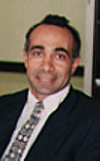CoteSys Colloquium
Invited Talk by Prof. Shahriar Negahdaripour

|
Prof. Shahriar Negahdaripour
(Faculty of Electrical and Computer Engineering, University of Miami) will be giving an invited talk on Thursday, Oct. 23, 1pm, in room MI 02.09.023
on
"Fusion of optical and sonar image measurements for automating visual tasks in underwater"
|
Abstract:
Visual surveying in underwater environments has become increasingly important in many scientific, commercial and military applications over the last decade. As for terrestrial applications, it is highly desired to design vision systems that enhance the autonomy of sensor platform deployment.
Despite advantages of high resolution and data rate while providing the most natural form of visual information for human interpretation, optical systems become ineffective in turbid waters. In recent years, a number of high-frequency sonar video imaging systems have become commercially available, which provide the capability to acquire acoustic images at sub-centimeter resolution in high turbidity. These are becoming the imaging sensor of choice for inspection tasks under very low visibility. Furthermore, underwater submersibles including ROVs and AUVs are being designed for deployment of these sonar cameras, in additional to the traditional monocular or stereo cameras.
Where visibility allows, integration of visual information from optical and sonar images provides the opportunity to automate a number of visual tasks, by extracting information about the shape and structure of objects in the field of view. As an example, overlapping optical and sonar views provide multi-modal stereo cues that can be exploited in a similar fashion binocular vision works with traditional pair of optical cameras.
In this talk, I will discuss a number of problems including stereo calibration, object 3-D reconstruction, and 3-D motion estimation based on the integration of visual cues in a so-called opti-acoustic stereo imaging system, while highlighting some of the advantage over traditional binocular system.

